

The VIsakhapatnam-Chennai Industrial Corridor (VCIC) has been in the spotlight lately, thanks to its mention in India’s 2024 Union Budget, where Nirmala Seetharaman specified that funds would be allocated for the industrial development of Kondaparthy – an important node in the corridor. The corridor itself is one that promises visible transformation and growth to Southern India – especially Andhra Pradesh, as 95% of the corridor is located here. In what ways could the Vizag-Chennai Industrial Corridor uplift India’s manufacturing and economy? Here’s all you need to know:
The VCIC is a key part of the planned East Coast Economic Corridor, which is India’s first coastal corridor. To that end, the VCIC is strategically aligned with the Golden Quadrilateral and positioned as a key driver of India’s “Act East Policy.” This initiative aims to integrate India and Andhra Pradesh’s economy with the dynamic markets of the Association of Southeast Asian Nations (ASEAN).
The long coastal stretch between Vizag and Chennai, and the strategically located ports along the way present the opportunity to create multiple international gateways that would connect India with the global production networks of Southeast and East Asia – which significantly contribute to the global manufacturing sector.
In a report given by AP Industries, it was emphasized that VCIC would be poised to drive growth around various sectors in North and South Andhra Pradesh, including:
Small and medium-sized enterprises (SMEs) will be a key focus within the corridor, with efforts to integrate them into modern supply chains. By clustering producers and suppliers in the same location, SMEs can benefit from regular interactions with global firms, observing and adopting advanced business models and practices.
Furthermore, the continued industrial development within Sri City in the south will contribute to Andhra Pradesh’s industrial base, while growth in traffic through the seaports and increasing power generation capacity will facilitate further economic development.
The VCIC will link economically backward regions with successful industrial hubs in Andhra Pradesh and Tamil Nadu, which will help create jobs and drive economic growth. These hubs, which focus on industries like automobiles, chemicals, petrochemicals, and food processing, are already connected with production networks in East Asia. The VCIC will increase investment and trade and encourage local producers to join global production networks, helping underdeveloped areas to grow economically.
When combined with efforts to integrate micro, small, and medium-sized enterprises (MSMEs) in sectors such as textiles and food processing into modern supply chains, increased connectivity between VCIC and backward regions will expand economic opportunities by providing MSMEs with forward linkages to vibrant urban centers and industrial clusters.
As a part of the East Economic Corridor, there will be a vibrant information and communication technology (ICT) sector in Visakhapatnam and Chennai – key nodes of the VCIC. While this will bolster the East Coast Economic Corridor’s (ECEC) communication infrastructure, it will also facilitate skills development in related service sectors and support the implementation of e-governance systems for effective maintenance, monitoring, and evaluation of corridor development activities.
While gathering regional industries, VCIC will attract companies in the value chain of other companies based in the corridor. In turn, industries will receive benefits like geographical position, advanced infrastructure, smooth access to industrial production units, decreased transportation
and logistics costs, improved delivery time, and a reduction in inventory costs.
As part of the Concept Development Plan, discussions were undertaken with the Government of Andhra Pradesh to understand their views on the selection of potential nodes for focused development. The locations were proposed by the state government, and included:
One of the main aims of VCIC, during its formulation, was to also aid in the increasing of India’s manufacturing GDP – a goal enlisted in the National Manufacturing Policy (NMP). As economic corridors have the potential to kickstart the country’s manufacturing sector and provide employment to millions in the workforce, VCIC would significantly contribute to that as well.
The Visakhapatnam-Chennai Industrial Corridor is a key component of the Indian Government’s ‘Make in India’ initiative, according to which economic corridors are policy instruments that prompt manufacturing and overall economic growth.
Stay tuned to Yo! Vizag website and Instagram for more city news updates.
This post was last modified on 29/07/2024 12:49 pm
Cricket fever is set to grip Visakhapatnam this October as the city plays host to…
The Government of Andhra Pradesh has introduced a new initiative to provide free JEE and…
If you're looking for an offbeat escape from Visakhapatnam this coming monsoon, head to Mahendragiri,…
Greater Visakhapatnam Municipal Corporation (GVMC) Mayor Peela Srinivasa Rao has stated that development projects for…
A major infrastructure boost connecting Andhra Pradesh and Telangana is on the horizon. The Khammam–Devarapalli…
Chief of Defence Staff (CDS) General Anil Chauhan is set to visit Visakhapatnam on June…
Leave a Comment